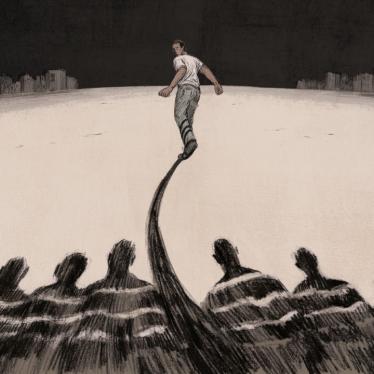Assembly Member Reginald Byron Jones-Sawyer, Sr., Chair
California State Assembly, Committee on Public Safety
Capitol Office, Room 2117
P.O. Box 942849
Sacramento, CA 94249-0059
Assembly Member Kevin McCarty
California State Assembly
Capitol Office, Room 2136
P.O. Box 942849
Sacramento, CA 94249-0007
Re: Human Rights Watch’s Opposition to AB 1542
Dear Assembly Members Jones-Sawyer and McCarty:
Human Rights Watch opposes the AB 1542 Yolo County pilot program that authorizes judges to sentence people to confinement in a locked treatment facility instead of prison or jail if the judge determines that their crime was motivated in part by substance abuse. We ask legislators to reject this bill and take a more holistic, rights-respecting approach to addressing problematic substance use and crime that may be connected to it.
The apparent premise of AB 1542 is that people with “Substance Use Disorders” (SUDs) have a medical condition that is best addressed through treatment as opposed to punishment. Human Rights Watch supports increasing the availability of evidence-based voluntary treatment for people who struggle with problematic use of psychoactive substances. However, this bill proposes forcing people involuntarily into “secured” or locked treatment, regulated by the courts, thus blurring the lines between medical care and punishment, and undermining the goal of helping those in need.[1] It runs directly counter to the principle of free and informed consent to mental health treatment, which is a cornerstone of the right to health. Conflating health treatment and jailing, as envisioned by AB 1542, risks substantial human rights abuse, is ineffective as a treatment, and takes resources and policy focus away from initiatives that are much more likely to help people.
AB 1542 Conflates Treatment with Punishment
AB 1542 would give judges power to sentence people convicted of crimes to “secured residential treatment” facilities if the judges determine that those people have SUDs that in any way contributed to the crime for which they were convicted.[2] Convictions for most criminal offenses, including trespassing, theft, delaying a police officer, drug sales and others, would be eligible.[3] Convictions for simple drug possession, sex crimes, or statutorily defined “serious” or “violent” crimes,[4] would be excluded.[5] Judges would be responsible for overseeing that treatment.[6]
However, judges lack the medical training or knowledge required to decide if a person has a medical condition or if substance use motivated their crime or to make decisions on the course of a person’s treatment. The bill does not require an evidentiary hearing to assess these underlying conditions; the health and human services agency conducts an assessment, but only after a person has been ordered into the locked treatment.[7] Further, judges’ decisions, particularly in overseeing progress in the program, may be influenced by factors related to punishment rather than prioritizing therapeutic benefit.[8]
While billed as an alternative to incarceration, permitting judges to confine people to a locked treatment facility essentially authorizes their imprisonment in that facility, even if there is an involuntary treatment component.
AB 1542 Standards Deny Due Process
The decision-making process envisioned by AB 1542 lacks defined standards, raising serious concerns about due process. The bill requires arresting police officers to write a “probable cause declaration” stating that the person arrested has an SUD and that the crime was drug related.[9] Police officers are not qualified to make such a diagnosis. The bill says nothing about procedures or standards for how courts are to make the ultimate decision, other than to permit judges to sentence people to the locked treatment if they determine the crime was caused in part by an SUD.[10] Judges also lack training to make such diagnoses, and the bill establishes no fact-finding procedure beyond the judges’ subjective beliefs. This pilot threatens to create a separate legal track for people perceived to have SUDs, with lowered due process, negatively implicating basic rights.[11]
The bill does call for consultation with the healthcare provider, but it does not establish the nature of that consultation.[12] It requires courts to use a risk and needs assessment tool to recommend the length and intensity of treatment upon entering the program.[13] By specifying “tool” as opposed to calling for a clinical assessment, this bill raises the specter of using formulaic checklists or algorithms to make diagnoses, instead of having health professionals conduct interactive examinations that allow for detailed input from patients. Risk assessment tools used in other aspects of the criminal legal system are known to produce racially discriminatory results, to reduce complex personal histories to out of context data-points, and to have adjustable scoring systems that can be used to increase incarceration rates regardless of need.[14] These tools should not be used to inform judicial decisions, especially as to medical treatment.
Even if amended to create stronger judicial procedures, to elevate input from treatment providers, and to remove the use of risk assessment tools, this program would remain objectionable because it is premised on coercing people into a locked treatment facility.
Coerced Treatment Violates Human Rights
Under international human rights law, all people have the right to “the highest attainable standard of mental health.”[15] Free and informed consent, including the right to refuse treatment, is a core element of that right to health.[16] People have a right to be free from forced mental health treatment.[17] Having a “substitute” decision-maker, including a judge, make orders for health care can deny a person their rights and infringe on their personal autonomy in health care.[18] The World Health Organization condemns involuntary mental health treatments as inconsistent with international human rights standards.[19] Due to the coercive circumstances under which the AB 1524 sentencing would take place, the treatment would not be voluntary.
In practice, courts will use the threat of jail or prison time to pressure people to plead guilty to a sentence of treatment, regardless of whether those people are independently willing or ready to accept treatment, and in many cases even if they do not need treatment. Prosecutors could simply demand longer prison or jail sentences in plea negotiations to leverage people into accepting this treatment “voluntarily.” This coerced process for imposing “treatment” undermines any therapeutic aim of the bill. Further, judges will be able to re-sentence to jail or prison if a person does not adequately comply with the terms of the locked program, meaning that the coercion continues throughout the course of treatment.[20]
The pilot program, as currently written, envisions sentencing people accused of misdemeanors and lower-level felonies to these locked facilities. People who would otherwise face little or no time in custody on these charges may be pressured into locked treatment if the judge or prosecutor wills it. Even if amended to limit application to felonies, the same pressure will remain. Time incarcerated in treatment can exceed time expected to be spent serving traditional jail or prison sentences for such crimes, as long as it does not exceed the maximum allowable term.[21] AB 1542 requires the judge to decide the length of time spent in the locked facility, unlike voluntary treatment which should be determined by the health professional and patient together.[22]
AB 1524 requires treatment providers to report the person’s therapeutic progress to the court, including to prosecutors who have an inherently adversarial relationship with the person, to probation officers, and to judges; it requires Yolo County to collect that individual’s data and to report it to the state.[23] It allows probation officers and prosecutors to have input into the course of treatment.[24] These provisions violate the right to confidentiality, a key component of the right to health.[25] This violation will undermine patient-healthcare provider relationships that are necessary to successful treatment outcomes.[26] By requiring healthcare providers to report treatment progress to the courts, including temporary failures in treatment, this bill compromises medical ethics requiring loyalty to patients.[27] Healthcare providers should be working directly with their patients, without outside interference especially from courts, to create good health outcomes.
Coerced Treatment is Ineffective
The coercion involved in this approach to treatment not only encourages abuse and violation of basic rights, it is also ineffective.[28] Like more traditional drug courts, this pilot may result in courts sentencing people who do not actually need treatment, wasting their time, and diverting resources from those who do.[29] For treatment to work, people generally must be willing and ready to accept it; compulsory treatment ignores this reality.[30] Blurring lines between treatment and incarceration, especially betraying patient confidences to judges and prosecutors who can order further jailing, damages the trust necessary for a person to embrace their treatment.[31] Studies of court ordered drug treatment generally have not shown positive outcomes.[32] Studies have correlated coerced treatment to increased occurrence of overdoses and relapse compared to voluntary treatment.[33]
California Should Invest in Voluntary Treatment and Supportive Services
Investing in carceral, involuntary treatment shifts resources away from providing voluntary treatment and the services necessary to make that treatment effective.[34] Instead of investing in locked facilities, Yolo County and the State of California could scale up treatment capacity for people who need and want to access it.[35] Providing well-resourced community-based options and removing barriers to treatment will help people mitigate problematic substance use.[36]
An initial draft of the pilot program bill explicitly stated that it was designed to address the homeless population in Yolo County, which has grown substantially in recent years.[37] The bill as introduced removed most of that language from its introduction, but the content of the pilot remains the same. Without addressing the need for housing and ongoing services, it is unlikely that locked treatment will help people experiencing homelessness improve their situation.
Yolo County and California would more effectively address these problems by providing more affordable housing and voluntary services and health care, instead of spending resources on incarcerating people in the name of treatment.
AB 1542 is simply a plan for more incarceration under the guise of treatment. More harmfully, it co-opts the language of the movement to address health problems related to crime with supportive solutions and redirects it toward more imprisonment. We ask that you reject this harmful pilot program and, instead, direct resources towards making voluntary treatment and other necessary services accessible to all.
Sincerely,
John Raphling
Senior Researcher, US Program
Human Rights Watch
cc.
Assembly Member Tom Lackey
Assembly Member Rebecca Bauer-Kahan
Assembly Member Sydney Kamlager
Assembly Member Bill Quirk
Assembly Member Miguel Santiago
Assembly Member Kelly Seyarto
Assembly Member Buffy Wicks
Yolo County Supervisor Oscar Villegas
Yolo County Supervisor Don Saylor
Yolo County Supervisor Gary Sandy
Yolo County Supervisor Jim Provenza
Yolo County Supervisor Angel Barajas
[1] “District Attorney Jeff Reisig’s Five-Point Plan to Reduce Homelessness,” Yolo County District Attorney, District Attorney Jeff Reisig's Five-Point Plan to Reduce Homelessness | Yolo County District Attorney (yoloda.org). DA Reisig is a primary proponent of AB 1524. He is presenting “involuntary residential treatment,” as envisioned by AB1524 as part of his response to rising homelessness.
[2] AB 1542, County of Yolo: Secured Residential Treatment Program (McCarty) 2021, Sec. 2, Sec. 1203.44(d).
[3] There is a proposed amendment to restrict this program to felony offense and exclude misdemeanors. While, this limitation would reduce the number of people exposed, it would not fix the harmfulness of the program or mitigate the objections we raise.
[4] California Penal Code sections 290(c), 1192.7(c), and 667.5(c).
[5] AB 1542, Sec. 2, Sec. 1203.44(b)(1).
[6] AB 1542, Sec. 2, Sec. 1203.44(d)(2).
[7] AB 1542, Sec. 2, Sec. 1203.44(a)(2).
[8] Physicians for Human Rights, Neither Justice nor Treatment: Drug Courts in the United States, (June 2017), p. 3. phr_drugcourts_report_singlepages.pdf
[9] AB 1542, Sec. 2, Sec. 1203.44(c).
[10] AB 1542, Sec. 2, Sec. 1203.44(d).
[11] Committee on the Rights of Persons with Disabilities, “Guidelines on article 14 of the Convention on the Rights of Person with Disabilities: The right to liberty and security of persons with disabilities,” (September 2015), par. 14, https://www.google.com/search?q=Guidelines+on+CRPD+article+14%2C+paragraph+21&rlz=1C1PRFI_enUS936US936&oq=Guidelines+on+CRPD+article+14%2C+paragraph+21&aqs=chrome..69i57j33i160.3045j0j7&sourceid=chrome&ie=UTF-8
[12] AB 1542, Sec. 2, Sec. 1203.44(a)(1).
[13] AB 1542, Sec. 2, Sec. 1203.44(a)(2) and (3).
[14] Human Rights Watch, “Submission to Illinois Supreme Court Commission on Pretrial Practices,” (June 26, 2019), Submission to Illinois Supreme Court Commission on Pretrial Practices | Human Rights Watch (hrw.org); Chelsea Barabas, Karthik Dinakar, Colin Doyle, “Technical Flaws of Pretrial Risk Assessments Raise Grave Concerns,” MIT Media Lab, (July 17, 2019), Technical Flaws of Pretrial Risk Assessments Raise Grave Concerns — MIT Media Lab.
[15] International Covenant on Economic, Social and Cultural Rights, (“ICESCR”), adopted December 16, 1966, entered into force January 3, 1976, Art. 12(1), OHCHR | International Covenant on Economic, Social and Cultural Rights.
[16] Human Rights Council; United Nations, General Assembly, “Report of the Special Rapporteur on the right of everyone to the enjoyment of the highest attainable standard of physical and mental health,” (March 28, 2017), Par. 64. A/HRC/35/21 - E - A/HRC/35/21 -Desktop (undocs.org)
[17] Convention on the Rights of Persons with Disabilities; Committee on the Rights of Persons with Disabilities: General comment No. 1 (2014), (May 19, 2014), par. 31. untitled
[18] Convention on the Rights of Persons with Disabilities; Committee on the Rights of Persons with Disabilities: General comment No. 1 (2014), (May 19, 2014), par. 41 and par. 31. untitled
[19] Freedom from coercion, violence and abuse. WHO Quality Rights core training: mental health and social services, 2019, p. 2-. https://apps.who.int/iris/bitstream/handle/10665/329582/9789241516730-eng.pdf?sequence=5&isAllowed=y
[20] AB 1542, Sec. 2, Sec. 1203.44(h).
[21] AB 1542, Sec. 2, Sec. 1203.44(d).
[22] AB 1542, Sec. 2, Sec. 1203.44(a)(6).
[23] AB 1542, Sec. 2, Sec. 1203.44(d), Sec. 1203.44(a)(8) and (9).
[24] AB 1542, Sec. 2, Sec. 1203.44(d).
[25] Neither Justice nor Treatment: Drug Courts in the United States, p. 20.
[26] Neither Justice nor Treatment: Drug Courts in the United States, p. 20.
[27] Neither Justice nor Treatment: Drug Courts in the United States, p. 20.
[28] Shawn Radcliffe, “Should People with Drug Addictions Be Forced Into Rehab?” Healthline, (June 25, 2018); Drug Addicts and Forced Rehab? (healthline.com).
[29] Joanne Csete and Denise Tomasini-Joshi, Drug Courts: Equivocal Evidence on a Popular Intervention, Open Society Foundation, (February 2015), p. 8, Drug Courts: Equivocal Evidence on a Popular Intervention - Open Society Foundations; Neither Justice nor Treatment: Drug Courts in the United States, p. 3.
[30] Richard M. Ryan, Martin F. Lynch, Maarten Vansteenkiste, Edward L. Deci, “Motivation and Autonomy in Counseling, Psychotherapy, and Behavior Change: A Look at Theory and Practice,” Invited Integrative Review, (2011), motivation-autonomy.pdf (apa.org); An Assessment of Opioid-Related Deaths in Massachusetts (2013-2014), Massachusetts Department of Public Health, (September 2016), p. 49, Microsoft Word - dph-legislative-report-chapter-55-opioid-overdose-study-9-15-2016 (mass.gov)
[31] Leo Beletsky, Wendy E. Parmet, Ameet Sarpatwari, “Expanding Coercive Treatment is the Wrong Solution for the Opioid Crisis,” Health Affairs, February 11, 2016, Expanding Coercive Treatment Is The Wrong Solution For The Opioid Crisis (updated) | Health Affairs
[32] Healthline; D. Webb, et al., “The effectiveness of compulsory drug treatment: A systematic review,” International Journal of Drug Policy, (February 2016) The effectiveness of compulsory drug treatment: A systematic review - ScienceDirect: Only 22% of studies reviewed showed positive outcomes for compulsory treatment. The rest showed either negative impact, no impact, or inconclusive data.
[33] An Assessment of Opioid-Related Deaths in Massachusetts (2013-2014), p. 49; Beletsky, et. al, “Expanding Coercive Treatment is the Wrong Solution for the Opioid Crisis”; Claude Rafful et al., “Increased non-fatal overdose risk associated with involuntary drug treatment in a longitudinal study with people who inject drugs,” Addiction, Vol. 113, Iss. 6, (June 2018) Increased non‐fatal overdose risk associated with involuntary drug treatment in a longitudinal study with people who inject drugs - Rafful - 2018 - Addiction - Wiley Online Library.
[34] Neither Justice nor Treatment: Drug Courts in the United States, p. 3.
[35] Beletsky, et. al, “Expanding Coercive Treatment is the Wrong Solution for the Opioid Crisis.”
[36] An Assessment of Opioid-Related Deaths in Massachusetts (2013-2014), p. 52, 57.
[37] “Yolo County Homeless Count,” Yolo County Homeless and Poverty Action Coalition, (January 22, 2019), p. 2, showdocument (yolocounty.org).







